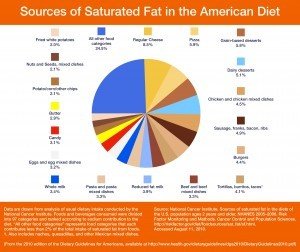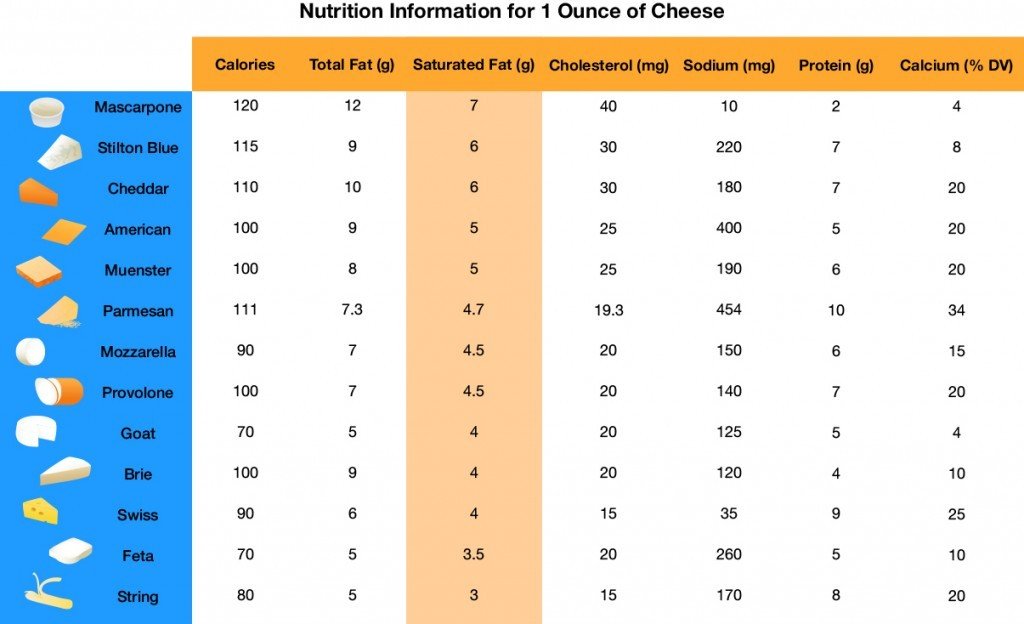Cheese 101
Did you know that cheese is one of the top sources of saturated fat in the American diet?It's true. Check out this chart from the Dietary Guidelines for Americans, which documents saturated fat in the eating habits of people in the United States. Why is this an issue? Well, saturated fat has been linked to many health issues. According to the Dietary Guidelines for Americans...
Why is this an issue? Well, saturated fat has been linked to many health issues. According to the Dietary Guidelines for Americans...
A strong body of evidence indicates that higher intake of most dietary saturated fatty acids is associated with higher levels of blood total cholesterol and low-density lipoprotein (LDL) cholesterol. Higher total and LDL cholesterol levels are risk factors for cardiovascular disease.Consuming less than 10 percent of calories from saturated fatty acids and replacing them with monounsaturated and/or polyunsaturated fatty acids is associated with low blood cholesterol levels, and therefore a lower risk of cardiovascular disease.
MyPlate adds its voice to these assertions, maintaining, "Saturated fats and trans fats tend to raise 'bad' (LDL) cholesterol levels in the blood. This, in turn increases the risk for heart disease. To lower risk for heart disease, cut back on foods containing saturated fats and trans fats." But how can people cut back on cheese and yet still enjoy it? Lynn Grieger RDN, CDE, CPT, CWC has some great ideas that she'd like to share with you and your clients...Cheese is not only a favorite food of many Americans, it’s also a good source of protein that fits into any meal or snack. With a wide variety of different types of cheese to choose from, consumers can pick the type that meets their taste, nutrition, and personal preferences. RDNs can steer consumers toward appropriate serving sizes, as well as highlight the differences in protein, total fat, saturated fat, sodium, and calcium content so that consumers are making the healthiest choice.I use a three-step approach to including cheese as part of a healthy diet:
But how can people cut back on cheese and yet still enjoy it? Lynn Grieger RDN, CDE, CPT, CWC has some great ideas that she'd like to share with you and your clients...Cheese is not only a favorite food of many Americans, it’s also a good source of protein that fits into any meal or snack. With a wide variety of different types of cheese to choose from, consumers can pick the type that meets their taste, nutrition, and personal preferences. RDNs can steer consumers toward appropriate serving sizes, as well as highlight the differences in protein, total fat, saturated fat, sodium, and calcium content so that consumers are making the healthiest choice.I use a three-step approach to including cheese as part of a healthy diet:
- Avoid processed cheeses such as American or Cheez Whiz. These include artificial ingredients and flavorings.
- Choose lower-fat and lower-sodium cheeses if you like the flavor of a particular cheese.
- Use smaller amounts of flavorful cheeses such as asiago or Roquefort.
Use these ideas to enjoy cheese without going overboard on calories, saturated fat, or sodium:
 Sprinkle a small amount of intensely-flavored cheese on top of a leafy green salad, or use a crumble of cheese on a sandwich.
Sprinkle a small amount of intensely-flavored cheese on top of a leafy green salad, or use a crumble of cheese on a sandwich.- Instead of using cheese as the primary flavoring in recipes, use a small amount of cheese as one of many different flavor components. For example, instead of a grilled cheese sandwich, use less cheese and add baby spinach and a spicy mustard for more intense flavors.
- Use 1 ounce of pre-packaged cheeses such as mini Babybel or part-skim milk string cheese for a snack, along with a piece of fruit or some raw vegetables.
So why cheese? Why now?Well, it may come as no surprise that this all started as a request from a reader. Elovia Peddle, RD, LD, CDE, emailed me to ask about goat cheese. Here's what she said...
Hi Judy,
I have a question that hopefully you can answer without any research.
Do you know the levels of saturated fat/cholesterol in goat cheese? There is no label on the product. Someone wanting to lower cholesterol levels asked me and I'm not knowledgeable about goat cheese.
Thanks.Elovia
Once I started looking through the nutrition information, I couldn't stop! Knowing the saturated fat and cholesterol in a variety of cheeses can help inform consumers and lead them to make healthful choices. So I decided to dig deeper, and that's how this post came to be!The fruit of all my research is here, in a comprehensive chart that compares the nutrition information in all kinds of cheeses. Take a look and download your free copy anytime! Plus, there's tons of information in the Nutrition Education Store! Here's a link to all the new products -- the store is overflowing!
Plus, there's tons of information in the Nutrition Education Store! Here's a link to all the new products -- the store is overflowing! And here are some nutrition resources that I think you'd particularly enjoy...
And here are some nutrition resources that I think you'd particularly enjoy...





